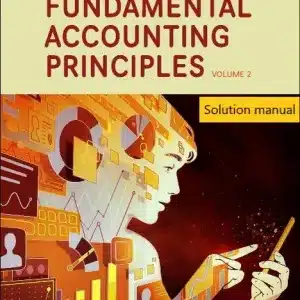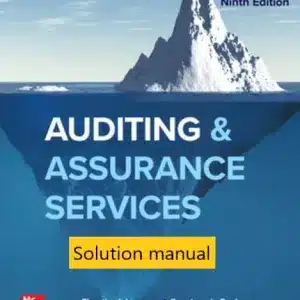Original price was: $39.99.$24.99Current price is: $24.99.
Solution manual for Fundamental Accounting Principles Volume 2 18th Edition By Kermit D. Larson © 2025
![]()
Product ID: 0914200
Downloadable link.
For Contact: [email protected]
Description
Solution Manual for Fundamental Accounting Principles, Volume 2, 18th Edition by Kermit D. Larson (© 2025)

Product Overview
The Solution Manual for Fundamental Accounting Principles, Volume 2, 18th Edition, by Kermit D. Larson is an indispensable learning tool for both students and instructors of accounting. This manual is structured to provide clear, systematic explanations of fundamental accounting concepts, helping students master the core principles of accounting. With a focus on clarity and simplicity, this manual makes it easier for students to understand and apply complex topics, building their confidence for both academic success and real-world application.
Designed to align with the Fundamental Accounting Principles textbook, this solution manual integrates McGraw-Hill’s Connect technology to create a dynamic, engaging learning experience. By combining comprehensive content with advanced learning management tools, it supports both students’ and instructors’ success in understanding and teaching accounting concepts.
Key Features of the 18th Edition Solution Manual
1. Direct, Concise, and Systematic Approach
The 18th Edition is renowned for its clarity and logical flow. It breaks down intricate accounting processes into easily digestible segments, ensuring students can grasp essential principles with ease. This structure enhances students’ ability to apply concepts in both academic settings and real-life scenarios.
2. Real-World Relevance
Engaging vignettes featuring dynamic entrepreneurs are included in each chapter. These practical examples show the real-world impact of accounting principles, making learning more relatable and encouraging students to think like business professionals. This approach is especially beneficial for those pursuing careers in business, finance, or accounting.
3. Integration with McGraw-Hill Connect Technology
The Solution Manual is integrated with McGraw-Hill’s Connect platform, offering advanced digital tools that enhance learning through:
-
Adaptive Learning Tools: These tools adjust to the student’s progress, providing a personalized learning experience.
-
Interactive Assignments: Students can apply what they’ve learned in real-life scenarios, reinforcing key concepts.
-
Learning Management System: Helps instructors track progress and manage assignments efficiently, saving time and improving course delivery.
4. Comprehensive Coverage of Accounting Topics
Volume 2 provides an in-depth exploration of advanced accounting topics, equipping students with a well-rounded understanding of key principles. The topics covered include:
-
Depreciation, amortization, and impairment of long-term assets.
-
Accounting for short-term liabilities, including accounts payable and loans.
-
Partnership accounting, including profit-sharing and earnings distribution.
-
Corporate reporting, focusing on earnings per share and retained earnings.
-
Bonds and long-term notes payable, debt investments, and cash flow analysis.
This volume ensures that students are prepared for both academic assessments and real-world financial challenges.
Detailed Content Overview for Volume 2
Chapter 9: Property, Plant, and Equipment and Intangibles
-
Focuses on depreciation, amortization, and impairment of long-term assets, ensuring students understand the management of these critical assets in business.
Chapter 10: Current Liabilities
-
Covers short-term liabilities such as accounts payable and loans, emphasizing their importance in day-to-day financial management.
Chapter 11: Partnerships
-
Explains the accounting treatment for partnerships, focusing on profit-sharing and distribution of earnings.
Chapter 12: Organization and Operation of Corporations
-
Discusses the structure of corporations, including stock issuance and dividend distributions.
Chapter 13: Corporate Reporting: Profit, Earnings Per Share, and Retained Earnings
-
Addresses key corporate reporting metrics, with a special focus on earnings per share (EPS) and retained earnings.
Chapter 14: Bonds and Long-Term Notes Payable
-
Detailed coverage of accounting practices for managing long-term debt, including bonds and notes payable.
Chapter 15: Accounting for Debt and Share Investments
-
Explains how to account for investments in both debt securities and equity securities, offering practical advice for investment accounting.
Chapter 16: Reporting and Analyzing Cash Flows
-
Provides a step-by-step guide to preparing and analyzing the cash flow statement, helping students understand financial liquidity.
Chapter 18: Analyzing Financial Statements
-
Teaches students how to use financial ratios and other analytical tools to interpret financial statements accurately.
Additional Resources in Volume 2
-
Appendix I: Payroll Liabilities
-
Recaps the accounting for payroll liabilities, ensuring students understand their impact on financial statements.
-
-
Appendix II: Financial Statement Information
-
Provides extra insights into interpreting financial statement data, enhancing students’ financial analysis skills.
-
-
Appendix III: Chart of Accounts
-
Lists the updated chart of accounts, serving as a quick reference for students and professionals.
-
For more Solution Manual, click her.






Clear explanation
Precise explanation
Saves effort